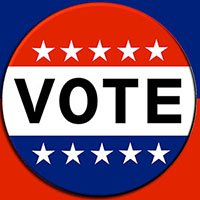— by Minor Lile, Orcas Issues Reporter —

Now it’s our turn. Super Tuesday has come and gone, and the Washington Presidential Primary is coming up next Tuesday, March 10. Every election season there are questions about the security and confidentiality of the electoral process. Especially so, it seems, in recent years. And particularly with the sometimes bewildering pace of technological innovation and its impact on privacy and trust. The following is a quick guide to voting and ballot security in San Juan County.
Voter Registration
There are currently over 13,500 registered voters in San Juan County. Just over 51% of voters in San Juan County voted in the 2016 Presidential primary, which was held in May of that year.
In order to vote in the Presidential primary, a person must be at least 18 years of age, a resident of Washington and free of any felony convictions. The deadline for in-person registration is no later than 8 pm on March 10. In person registration is available at the county elections office at 55 Second St, Suite A in Friday Harbor. The deadline for registering to vote in the Presidential primary by mail or online has already passed.
The completed ballot must be postmarked by March 10 or deposited in a ballot drop box by 8 p.m. that evening. This means that if you are mailing the ballot, it must be at the Post Office by closing time, which is 3 p.m. in Eastsound and 2:30 p.m. in Deer Harbor and Orcas. If you use a collection box, the pick-up time is 1:15 p.m. in Olga and 2 p.m. in Eastsound. Ballots that are deposited at the post office or collection box after these times will not be postmarked until the following day.
If you miss the deadline for using the post office there is one ballot drop box on Orcas Island. It is located at the Senior Center, 62 Henry Road. The deadline for using the drop box is 8 p.m. on March 10.
Voting in the Presidential Primary
For the Presidential primary, a person must declare which political party’s primary (Republican or Democrat) they are choosing to vote in. This declaration is made on the ballot return envelope and not on the ballot itself. The declaration of party preference is available as a public record as is the fact that an individual has voted. Voters do not have to declare a political party preference to vote in the August primary or November General Election.
Participating in the Presidential primary is open to any political party that received at least 5% of the vote in the last Presidential election.
As of March 4, only 4 of the 13 candidates listed for the Democratic Party are still running: Joseph R. Biden, Tulsi Gabbard, Bernie Sanders, and Elizabeth Warren. The reason there are so many candidates listed on the ballot is essentially the result of a timing issue. Both major political parties were required to provide the list of candidates that are to appear on the ballot by January 7. This is so that ballots can be mailed to eligible overseas voters and military personnel at least 45 days prior to the primary date. Once the list has been provided to the Office of the Secretary of State, no changes are allowed.
For the Presidential primary, ballots are only counted if the voter has checked their party preference on the ballot envelope and selected a single option in the appropriate party column.
If more than one candidate is selected or a candidate is selected for both parties, the ballot is invalid and will not be counted.
On the Democratic side of the ballot, voters may choose an ‘uncommitted delegates’ option rather than an individual candidate. A vote for uncommitted delegates allows those with that designation to vote for whom they choose during the Democratic Party National Convention in July. On the Republican side of the ballot, the only selections available are President Donald Trump or a write-in candidate.
Write-ins are allowed on both the Republican and Democratic side of the ballot. In Washington, write-ins are only counted if the write-in candidate has filed a proper declaration of candidacy. The deadline for write-in candidates is up to 8 p.m. on the day of the election.
Voting Security and Confidentiality
Prior to every major election, the Secretary of State’s office requires each of the 39 counties in the State to conduct a Logic and Accuracy test of the vote tabulation system. In San Juan County, this test was conducted on February 24 at the Election Supervisor’s office in Friday Harbor. With three public observers present, as well as a representative of the Secretary of State’s office, Elections Supervisor Camolyn Armstrong, and County Auditor Milene Henly, a test set of 124 dummy ballots were run through the tabulation machinery and accurately counted.
A reassuring aspect of the mail-in voting process in San Juan County is that state law requires that the tabulation of votes can be tied back to paper ballots. State law also requires that each county election office retain the paper ballots for a period of up to two years. The actual time depends on the election. For the Presidential primary, the ballots are retained for 22 months.
In past years, there have been questions raised from time to time about the barcode that appears on the right side of the ballot. According to Camolyn Armstrong, the Election Supervisor for San Juan County, this barcode does not contain any personally identifiable information. It is only used for verification of the election date and to identify the precinct that the ballot came from. There are 19 precincts in San Juan County.
In every election there are a few voters who cut this barcode off their ballot. Ballots with missing barcodes are still counted, but they must be processed manually. This typically adds about 20 minutes per ballot to the time it takes to tabulate results. Using ink colors other than blue or black also requires manual inspection of the ballot and slows down the tabulation process.
Another question that is often asked is about the tear-off stub at the top of the ballot. According to Armstrong, the purpose of the stub is to serve as a quality control device. There is a small 2D barcode that is placed on the stub. During mail assembly we match the barcode on the stub to the barcode on the envelope. This assures that every voter is getting the correct precinct, and, if applicable, party and language on their ballot.
While measures are taken to assure the confidentiality of each ballot and who a person voted for, whether or not a person voted is a matter of public record.
Voting Tabulation and Results
The elections office begins to compile results as the mail-in ballots are received. There is a team of volunteer election workers who help with this process. For the Presidential primary, Democrat and Republican party representatives are also allowed to be present if they choose.
Counting the vote is a five-step process. The first step is to separate the ballots from the mailing envelope and remove them from the security sleeve. The second step is to scan and review each of the ballots. The next step is to tabulate the vote.
San Juan County uses voting tabulation equipment and software provided by Hart Intercivic, a Texas-based company that has been making voting equipment since 1912. Fourteen other counties in the State also use Hart Intercivic voting equipment.
The fourth step is to review the results and upload the information to the San Juan County election results webpage and to the Office of the Secretary of State in Olympia. After the votes for the Presidential primary have been tabulated, the paper ballots are locked up and kept in storage for a period of 22 months. This is the fifth and final step in the process.
Because the deadline for mail-in voting is on election day, it usually takes several days for all the votes to be received and tabulated by the Elections office. The statewide deadline for County Canvassing Boards to certify the primary results is March 20.
**If you are reading theOrcasonian for free, thank your fellow islanders. If you would like to support theOrcasonian CLICK HERE to set your modestly-priced, voluntary subscription. Otherwise, no worries; we’re happy to share with you.**









The post office in Olga closed last Friday. Take your ballots to the Eastsound post office or drop them off at the ballot box just outside at the Senior Center.
Minor, thank you so much for a very informative piece. Although I’ve voted in every election since I was 18, I learned things I’ve never known about our voting process. Let’s all do our parts now. If you haven’t already mailed in your ballot, then vote in person next Tuesday.
Even if you were a passionate supporter of a candidate who has withdrawn from the Primary; even if you haven’t voted for years; I hope you will participate by voting now. And if not in the Primary Election, at the very – least in November!